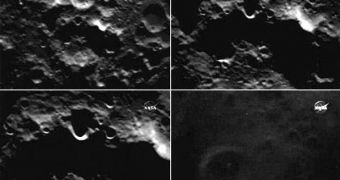Yesterday, October 9, the Lunar CRater Observation and Sensing Satellite (LCROSS) collapsed into the Cabeus crater at the lunar south pole, just minutes after it dropped its spent Centaurus upper stage at the same location. Just before impacting the ground, the Science team at the Ames Research Center reported that it had seen the impact crater left behind by the rocket stage, although details of the actual impact are sketchy at this point. Friday's impact may have been a disappointment for those waiting for a huge explosion to be visible, Space reports.
“We saw a crater. We saw a flash. So something had to happen in between,” NASA's principal investigator, Tony Colaprete, said yesterday. The $79-million lunar probe, which took off on the same delivery system as the Lunar Reconnaissance Orbiter (LRO), carried a suite of nine instruments, including high-speed cameras and spectrometers, so chances are that it managed to snap a considerable number of photos before plunging to its demise, several kilometers away from the Centaurus impact site. The crater left behind by the upper stage is, as predicted, about 66 feet (20 meters) in diameter.
Over the past few weeks, NASA experts have warned Earth-based observers that detecting the plume of debris ejected by the Centaurus stage at an estimated height of about six miles (ten kilometers) will be extremely difficult. Colaprete likened observing it to searching for patches of darkness that were less dark than their surroundings. But experts at the space agency take solace in the fact that the LCROSS managed to transfer a lot of data before being destroyed, and also that the LRO was flying some 50 kilometers above the impact crater, while snapping pictures of the event.
“The moon we thought we knew is not the moon we know now. The results that we'll get from LCROSS are an important piece in the puzzle of something that is pretty darn new, the hydration cycle on the moon,” Mike Wargo, NASA's chief lunar investigator, added. He shared that, while the plume of dust ejected by the Centaurus stage was not observable in visible wavelengths, signs of it were detected with infrared instruments, proving for certain that the impact did occur as calculated.
“We're just looking at the very preliminary images to get a sense of the types of data that have been collected. But it's too early to tell, to make that determination,” the LCROSS Observation Campaign lead investigator, Jennifer Heldmann, said.

 14 DAY TRIAL //
14 DAY TRIAL //